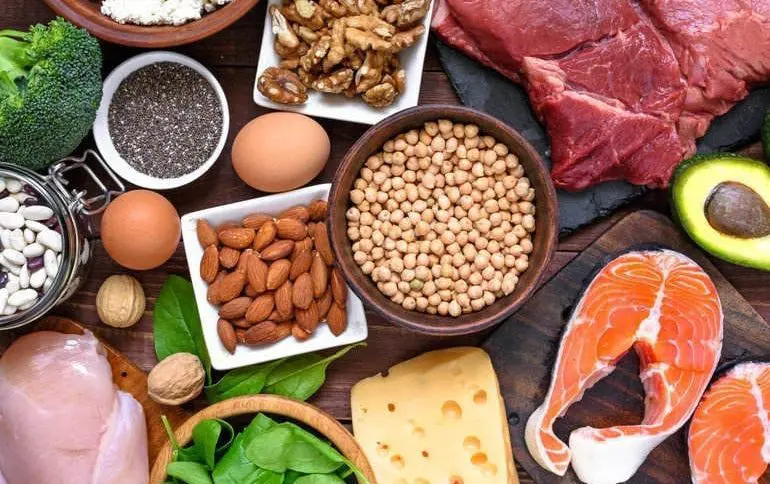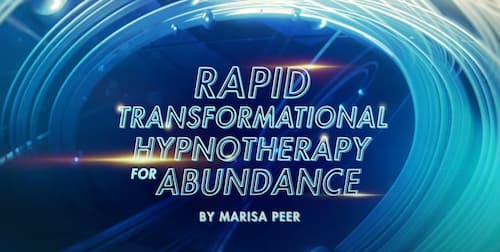So you want to follow a healthy diet and you take a close look at your options: Paleo vs. Keto, Blood type, Atkins, Vegan, Mediterranean, and the list goes on… Majority of most of these diets have one thing in common, and that’s “high protein foods”.
95% of your body weight is dependent, not on exercise, but on what you eat.
— Eric Edmeades, Author of Mindvalley’s WILDFIT Quest
“Why is protein such as highly prized nutrient, compared to its siblings: carbohydrates and fats?”
That’s because protein is responsible for our cell growth and development. Without protein, our cells can’t grow or repair themselves.
It’s undeniable that protein is a vital nutrient for our health.
However, not all foods with protein are good for your body.
In this article, you’ll learn what you don’t know about protein and a comprehensive list of high protein foods.
So, let’s get cooking.
What Is Protein?
“What is a protein?”
Protein is one of the three macronutrients that our body needs in sizable amounts alongside carbohydrates and fats.
Protein is often referred to as our bodies’ building block because of its central role in cell growth and development.
What does protein do?
Protein also makes up the most significant amount of nutrients in our body. That’s because every single cell in our blood, organs, tissues, and muscles require protein to grow, repair, and maintain themselves.
Proteins generally have many functions and are classified into nine types of proteins.
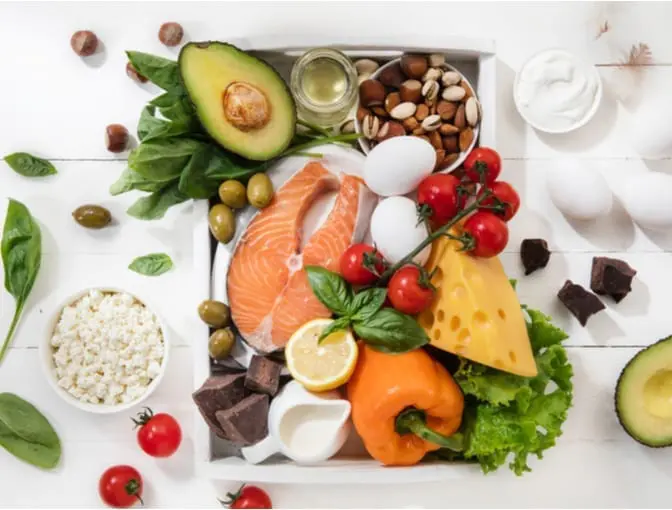
What Are the Nine Types of Proteins?
Protein has many roles in our bodies, from aiding in muscular strength and growth to transporting nutrients around the body, depending on the type of protein.
They are categorized into nine types of proteins:
| Types Of Proteins | Function | Example of proteins |
| Enzymatic | Build and break down molecules | Lactase and amylase |
| Structural | Strengthen cells, tissues, organs, and more | Collagen |
| Signaling | Allows cells to communicate with each other | Insulin |
| Regulatory | Turn genes on and off | Estrogen |
| Transport | Move nutrients around the body | Hemoglobin |
| Sensory | Detect light, sound, touch, smell, taste, pain | Opsins in the eye detect light |
| Motor | Move and change the shape of cells to help us move | Myosin |
| Defense | Fight infections and heal damaged wounds | Antibodies |
| Storage | Store nutrients for later use | Casein stores milk protein |
Does protein give you energy?
Our primary source of energy comes from carbohydrates and fats. In cases where our bodies are not getting enough energy from nutrients and stored fats, protein is used as an energy alternative.
Also, excess proteins get converted and stored as fat for future energy use.
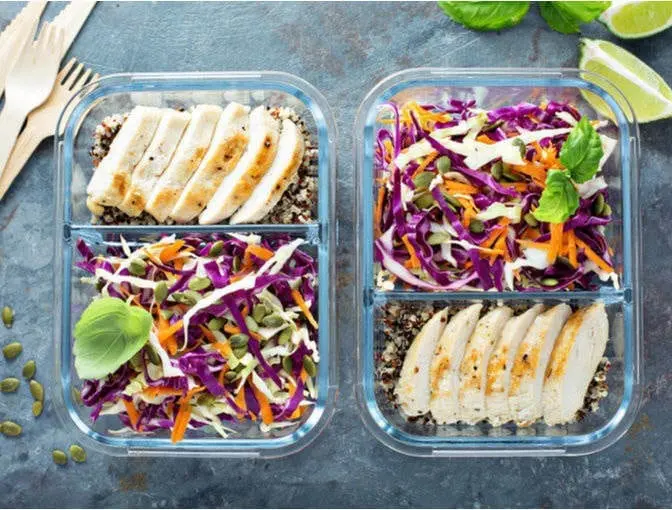
How Much Protein Do You Need Per Day?
There’s no one right answer. Different people have different body compositions, health goals, and levels of physical activity. Even after taking all this into account, you’ll end up with a starting number, which is just a guideline.
You need to start experimenting to find out how much protein do you need a day.
The table below shows the amount of protein (g/kg) you need depending on your current weight, health goals, and lifestyle.
For example, if you’re 75kg, have an active lifestyle and want to maintain your weight, the recommended protein intake is between (1.4 x 75) to (1.6 x 75).
| Inactive Lifestyle | Active Lifestyle | Obese/Overweight |
| 1.2g/kg | Maintain weight: 1.4-1.6g/kg | 1.2-1.5g/kg |
| Gain Muscles: 1.4-2.4g/kg | ||
| Lose Weight: 1.8-2.7g/kg |
If you’re a vegan or on a plant-based diet, you need to increase your protein consumption. This is because plant-based proteins are usually inferior to animal-based proteins as your body tends to absorb more protein from animal-based products.
This means your body absorbs different amounts of protein depending on the food source, which you’ll learn in the next section.
How much protein can your body absorb?
The percentage of protein the body can use depends on the protein source.
For example, your body can use 100% of the protein in an egg, whereas for plant-based foods, you end up absorbing less than 50% of the protein.
Your physical activity, muscle mass, and body composition also determine your body’s protein absorption rate.
A study showed that there’s no significant boost in muscle protein synthesis in meals with more than 30g of protein.
Meaning that our body uses around 30g of protein for muscle growth, and any excess protein will be used for other functions or converted to fats.
How much protein per day to lose weight?
Weight loss is a byproduct of health.
— Eric Edmeades, Author of Mindvalley’s WILDFIT Quest
The ideal amount of protein for people who want to lose weight depends on their level of physical activity, body composition, and various factors.

Generally speaking, it is recommended to take at least 1.2g of protein per kilogram of body weight per day (0.54 g/lbs).
If you’re 80kg, this means you need at least 96g of protein per day.
Keep in mind that this doesn’t mean more protein is better.
Having too much protein in your diet can be harmful to your health. Read on to find out what are the symptoms of overconsumption of protein.
How Much Protein Is Too Much?
Anything 2-3 times the recommended amount of protein is considered too much.
Have you ever wondered what happens if you eat too much protein?
As the adage goes, too much of a good thing can be bad for you. If you’re eating too much protein, your health could suffer from a number of side effects of protein.
The symptoms related to overeating protein include:
- Dehydration
- Indigestion
- Sudden exhaustion
- Nausea
- Headache
- Diarrhea
Serious risks associated with constant protein overconsumption include:
- Cardiovascular disease
- Blood vessel disorders
- Liver and kidney injuries
- Seizures
- Type-2 diabetes
- Cancer
- Osteoporosis
As long as you keep your daily protein intake within the range (slightly more is okay), you’re good.
Does protein make you fat?
Good question.
If you eat a lot of protein and excess protein gets converted to fat, does protein make you fat then?
Yes.
Calories can go over the roof when you increase your protein intake. This can lead to weight gain over time, specifically for women because their metabolism is slightly lower compared to men.
In this case, the best protein for women (and men) are lean proteins and plant-based proteins.
What Are the Sources of Protein?
This is your definitive guide to the best high-protein foods you need to eat.
Whether you want to get in better shape, increase your muscle mass or simply eat healthier, this list introduces foods high in protein and low in fat that help you hit your health goals.
Nothing tastes as good as health and longevity feels.
— Eric Edmeades, Author of Mindvalley’s WILDFIT Quest
1. Chicken breast
Let’s kickstart the list with the best animal protein, chicken breast.
The best part about chicken breast is that the majority of the calories come from protein.
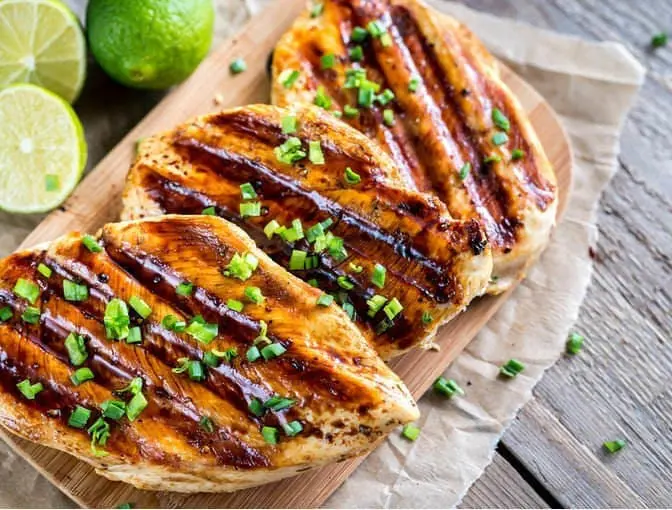
Plus, chicken is loaded with essential micronutrients such as selenium, phosphorus, vitamin B12, and niacin.
Protein in chicken: A piece (272g) of skinless chicken breast contains 326 calories, 61.2g of protein, and 7.13g of fats.
One thing to note: Be sure to remove the skin and any visible fats to reduce even more calories.
2. Turkey breast
The star of holiday feasts, turkey!
Though turkey is often associated with feasts, its breast cut tops the list of highest protein foods. It is packed with protein and nutrients, namely B vitamins, niacin, choline, selenium, and zinc.
Protein in turkey: A 4-ounce (113g) skinless turkey breast contains 129 calories, 27.6g of protein, and 1.7g of fats.
3. Lean beef
Protein in steak shouldn’t be excluded as well, particularly lean beef. It is packed with iron, vitamin B12, and large amounts of other important nutrients.
Protein in beef: A 4-ounce of 95% lean raw ground beef contains 155 calories, 24.2g of protein, and 5.6g of fats.
One thing to note: You should avoid processed meat because they contain additives, preservatives, and other chemicals harmful to your health.
4. Lean pork
Being high in protein and rich in many nutrients, lean pork can add an extra protein boost to your diet.
Protein in pork: One piece (180g) of lean pork chop offers 351 calories, 55.8g of protein, and 12.4g of fats.
One thing to note: not all pork cuts are lean proteins. Choose cuts that have words like “loin” or “chop”.
5. Fish
The best fish you should eat are those with great nutritional profiles, specifically high in heart-healthy omega-3 fats.
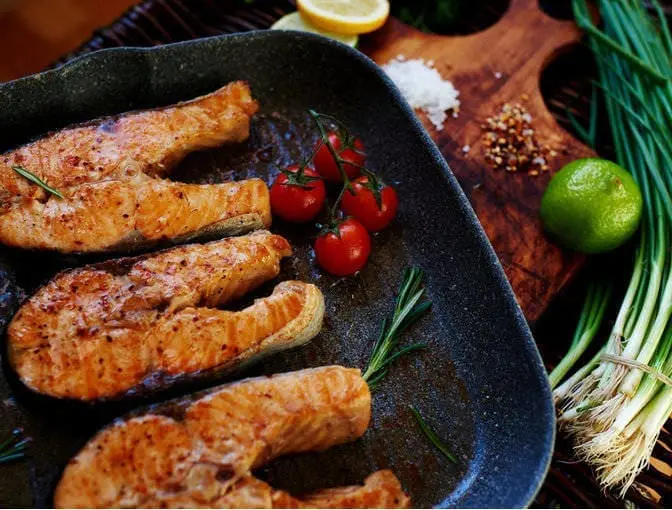
Fish that you should avoid are those with a high amount of mercury such as king mackerel, tilefish from the Gulf of Mexico, sharks, and swordfish.
Protein in fish: One fillet (112g) of raw Atlantic mackerel contains 230 calories, 20.8g of protein, and 15.6g of fats.
Examples of low-fat fish are codfish, flounder, haddock, tuna, halibut, tilapia, mahi-mahi, and pollock.
6. Shrimp
Shrimp usually tops the list of low-calorie foods.
One reason why shrimp is regarded as one of the best high-protein foods is that it doesn’t contain any carbohydrates and 90% of its calories come from protein.
Protein in shrimp: A 3-ounce (85g) serving of shrimp contains 84 calories, 17.8g of protein, and 0.9g of fats.
Fun fact: Do you know shrimps are one of the best natural sources of iodine, a nutrient that most people lack?
7. Milk (non-dairy)
“Got milk? Good for you!”
Chances are, you’ve stumbled upon ads saying “milk is good for you”. While it is high in milk protein and calcium, 65% of the global population intolerant to dairy milk is a clue.
Fast forward, non-dairy milk is the safest and healthiest way to go — for instance, soy milk, almond milk, rice milk, oat milk, and coconut milk.
Protein in soy milk: One cup of organic unsweetened soy milk contains 80 calories, 7g of protein, and 4g of fats.
8. Eggs
An eggcellent choice of food high in protein.
Besides being loaded with healthy protein, eggs also help people feel more satisfied and prevent them from overeating.
How many grams of protein are in one egg?
One large hard-boiled egg (50g) contains 211 calories, 17.1g of protein, and 14.4g of fats.
Fun fact: Do you know eggs are second only to mother’s milk for human nutrition?
9. Swiss Cheese
One more reason for you to indulge in cheese.
Swiss cheese is one of the high-protein cheeses perfect for people on a low-sodium diet. It also contains peptides that were linked to a decreased risk of hypertension.
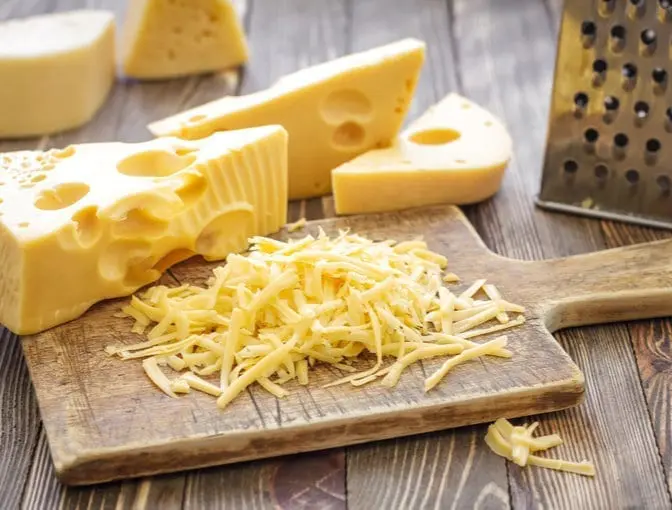
Protein in Swiss cheese: One ounce (28g) of swiss cheese has 111 calories, 7.6g of protein, and 8.8g of fat.
10. Edamame
These cute little green beans are immature soybeans.
They may not sound appetizing, but they’re a great source of plant protein.
Protein in edamame: One cup (156g) of shelled edamame contains 188 calories, 18.4g of protein, and 8g of fats.
Fun fact: Some of the edamame’s health benefits include supplying you with calcium and vitamin K, which is a double-win for your bones.
12. Soybeans
Soybeans may not be as popular as their processed children like tofu, tempeh, and milk, but they are very versatile and can be cooked with many kinds of foods.
You can boil, steam, bake, stir-fry, or smash them into patties.
Protein in soybeans: A 3.5-ounce (100g) of boiled soybeans contains 173 calories, 16.6g of protein, and 9g of fats.
13. Tofu
Tofu, made from soybean curds, is one of the few plant proteins that provide all 9 essential amino acids (all soy products are complete proteins).
It is naturally gluten-free and low in calories, which makes it a great source of soy protein.
Protein in tofu: A half-cup (126g) of raw firm tofu contains 181 calories, 21.8g of protein, and 11g of fats.
What makes tofu a magical food is primarily thanks to its isoflavones that have been linked to a reduced risk of certain types of cancer (breast and prostate cancer), osteoporosis, and cardiovascular diseases.
14. Tempeh
Tempeh is tofu’s superior brother. They’re made from the same soybeans, but tempeh’s protein content is significantly higher than tofu.
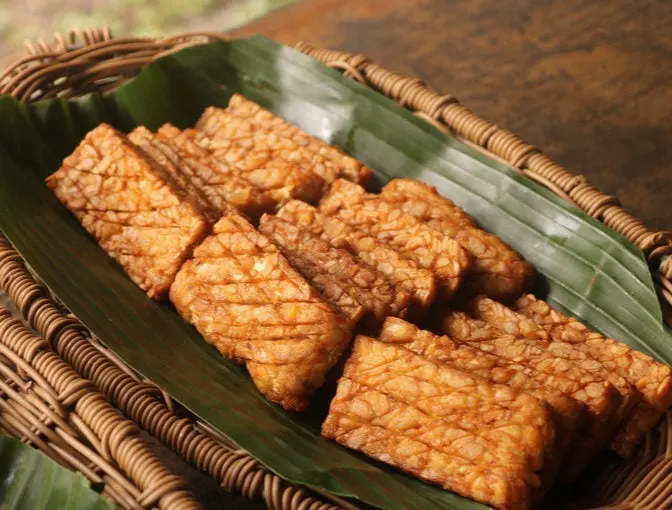
Why?
It’s because tempeh is usually combined with nuts, seeds, legumes, or whole grains. These are all protein powerhouses packed in a single block.
Protein in tempeh: A 3-ounce (85g) serving of tempeh contains 162 calories, 15g of protein, and 9g of fats.
15. Lentils
Another protein powerhouse on the list.
While lentils are economical in their dried forms, their nutrition profiles should never be underrated. They are high in fiber, protein, magnesium, folate, and various other nutrients.
Protein in lentils: A 3.5-ounce (100g) of cooked lentils contains 116 calories, 9g of protein, and 0.4g of fats.
16. Chickpeas
An essential ingredient in hummus, chickpea, is one of the highest protein foods.
Chickpea is an excellent substitute for meat and can add a significant amount of protein to your diet. On top of that, chickpeas also help to prevent several health conditions like diabetes, high blood pressure, and high cholesterol and help in weight loss.
Protein in chickpea: A 1-ounce of cooked chickpea (28g) contains 46 calories, 2.5g of protein, and 0.7g of fats.
17. Kidney beans
Kidney bean, a peculiar bean that resembles our kidneys, is a variety of the common bean.
They come in many colors, namely red, white, cream, black or purple. Despite the color difference, their nutritional profiles are quite similar.
Protein in kidney beans: A 3.5-ounce (100g) of boiled kidney beans has 127 calories, 8.7g of protein, and 0.5g of fats.
18. Black beans
Also known as turtle beans because of their hard, shell-like appearance, black bean is a type of legume that is rich in protein.
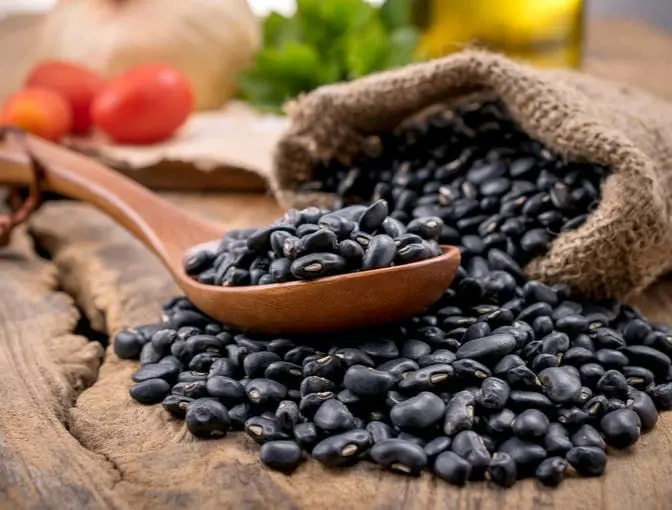
Among many benefits, black beans may help strengthen bones due to the bone-healthy nutrients like iron, phosphorus, calcium, magnesium, and zinc present in all black beans.
Protein in black beans: One cup (172g) of black beans has 227 calories, 15.2g of protein, and 1g of fats.
19. Pinto beans
Pinto beans are most often found in burritos.
They are one of the foods high in protein, phosphorus, manganese, and folate, and exceptionally high in dietary fiber. It’s the perfect addition to a healthy lunch.
Protein in pinto beans: 1 cup (171g) of pinto beans has 245 calories, 15.4g of protein, and 1.1g of fats.
20. Flaxseeds
Some may call it the all-powerful plant on the planet. There’s some evidence showing that flaxseeds may help reduce the risk of heart disease, cancer, stroke, and diabetes.
Even though flax seeds contain all kinds of healthy compounds, it owes their healthy reputation primarily to three things: omega-3 fatty acids, lignans (plant estrogen and antioxidants), and fiber.
Protein in flax seeds: One ounce (28g) of flax seeds contains 152 calories, 5.2g of protein, and 12g of fats.
21. Chia seeds
Chia seeds were a staple food for the Aztecs since 5,500 years ago for several good reasons: they can help boost fiber, protein, calcium, antioxidants, and omega-3s in your diet.
Protein in chia seeds: One ounce (28g) of chia seeds has 138 calories, 4.7g of protein, and 8.7g of fats.
Fun fact: Do you know the Aztecs offer chia seeds as offerings to their gods?
22. Pumpkin Seeds
Used to be a common ingredient in Mexican cuisine, pumpkin seeds are now eaten as protein foods, and snacks, or used in cooking all around the world.
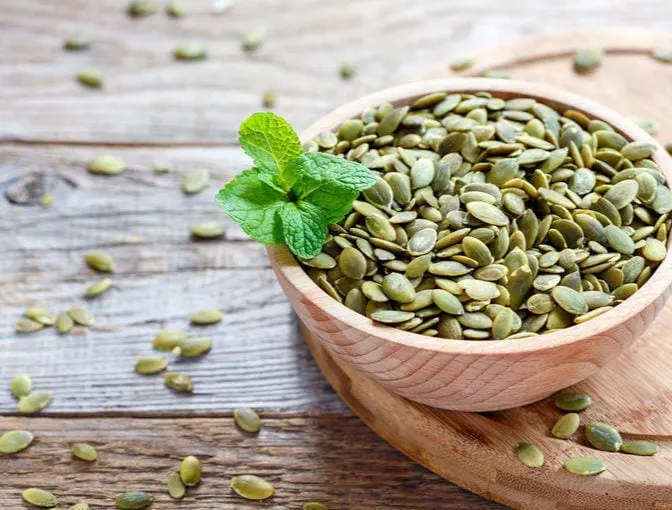
They’re a great source of protein, zinc, healthy omega-3 fatty acids, magnesium, and a natural source of tryptophan — which helps in improving sleep.
Protein in pumpkin seeds: One ounce (28g) of pumpkin seeds contains 142 calories, 5.7g of protein, and 9.4g of fats.
23. Hemp seeds
Although hemp seeds and marijuana come from the same species, hemp seeds contain less than 0.3% tetrahydrocannabinol (THC) — the chemical responsible for most of marijuana’s psychoactive effects.
Hemp seeds are loaded with essential nutrients such as plant protein, heart-healthy omega-3s, dietary fiber, and gamma-linolenic acid (GLA). GLA is often used to treat skin conditions, high cholesterol, heart, disease, and metabolic syndrome.
Protein in hemp seeds: One ounce (28g) of hemp seeds has 157 calories, 9g of protein, and 13.8g of fats.
24. Almonds
The demand for almonds has quadrupled since 1980, and there’s a good reason for that.
Almonds with their unique nutrient combo — plant-based protein, fiber, monounsaturated fat, vitamin E, and magnesium — made them a food high in protein and a healthy boost to our diets.
Protein in almonds: One ounce (28g) of whole almonds contains 164 calories, 6g of protein, and 14.2g of fats.
25. Peanuts
You see peanuts everywhere — desserts, cakes, confectionery, snacks, sauces, spreads, and more. But the healthiest form of peanut with the highest protein is dry-roasted peanut (unsalted and unsweetened).
Protein in peanuts: One ounce (28g) of dry-roasted peanuts has 167 calories, 6.9g of protein, and 14.1g of fats.
Fun fact: Surprisingly, peanuts are actually related to beans rather than nuts.
26. Pistachios
Originating from Central Asia and the Middle East in 7000 BC, pistachios made their way to Western countries in the 19th century and became popular in many dishes.
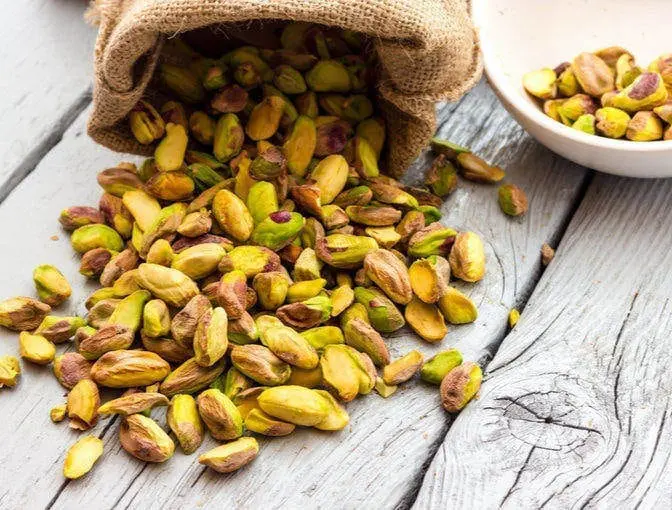
Pistachios are foods high in protein that are packed with antioxidants and fiber beneficial to our health in various ways.
Protein in pistachios: One ounce (28g) of dry-roasted pistachios contains 162 calories, 6g of protein, and 13g of fats.
27. Cashews
Ever heard of cashew milk?
It’s not surprising to see cashews being widely used to make dairy alternatives like cashew milk and cashew cheese.
Cashews have several possible health benefits — such as reducing the risk of cardiovascular diseases, aiding in weight loss, and improving bone health.
Protein in cashews: One ounce (28g) of dry-roasted cashews has 163 calories, 4.3g of protein, and 13.2g of fats.
28. English walnuts
Studies have found that nuts can help reduce rates of cardiovascular diseases, and walnuts are a notch above.
This is because of the uniqueness of nutrients in walnuts. They contain a lot of polyunsaturated fatty acids, nutrients with anti-inflammatory effects, antioxidants, and omega-3s.
Protein in English walnuts: One ounce (28g) of walnuts contains 186 calories, 4.3g of protein, and 18.5g of fats.
29. Khorasan grains
Have you ever tasted a sweet, nutty, buttery grain?
Meet Khorasan, an ancient wheat that’s attracting interest from pasta makers, bakers, and consumers alike.
Not only because it’s a food high in protein, but it is also easier to digest and has shown promising results in reducing total cholesterol compared to modern wheat.
Protein in Khorasan: One cup (172g) of Khorasan contains 227 calories, 9.8g of protein, and 1.4g of fats.
30. Teff grains
A grain the size of a poppy seed that is widely farmed in Ethiopia, teff is naturally high in protein and minerals.
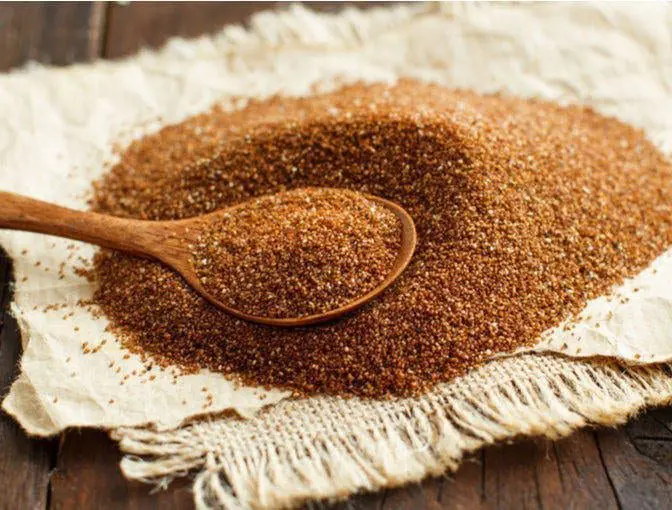
Today, teff is used as ingredients in pancakes, breads, cakes, and cereals, especially gluten-free products.
Protein in teff: One cup (252g) of cooked teff has 255 calories, 9.8g of protein, and 1.6g of fats.
31. Quinoa
Quinoa, often described as a “superfood”, has become popular among vegans and health-conscious people, for good reasons.
It is one of the high protein foods that are gluten-free and contains fiber and various minerals and vitamins, including iron, copper, thiamin, and vitamin B6.
Protein in quinoa: One cup (185g) of cooked quinoa contains 222 calories, 8.1g of protein, and 3.6g of fats.
Fun fact: Although quinoa is cooked as grain, they actually belong to the “seed” category.
32. Whole wheat pasta
A 100% whole wheat pasta is way healthier than its refined cousin, white pasta, but why?
This is because whole wheat pasta includes all three layers of the wheat kernel: the bran, the germ, and the endosperm.
Most nutrients are present in the bran and germ, which are removed during the making of refined wheat. This is why you might want to avoid white pasta and white breads which are made of white flour.
Protein in whole wheat pasta: One cup (117g) of cooked spaghetti has 174 calories, 7g of protein, and 2g of fats.
33. Wild rice
Another champion of the “whole grain” category, wild rice is very nutritious and believed to be housing powerful antioxidants and fiber.
Wild rice tops the high protein foods list among regular grains. Though it is not a rich protein source, wild rice is considered a complete protein — which means it contains all nine essential amino acids.
Protein in wild rice: One cup (164g) of cooked wild rice contains 166 calories, 6.5g of protein, and 0.6g of fats.
34. Spinach
Popeye’s favorite food, spinach! We used to wonder why Popeye became so much stronger right after eating spinach.
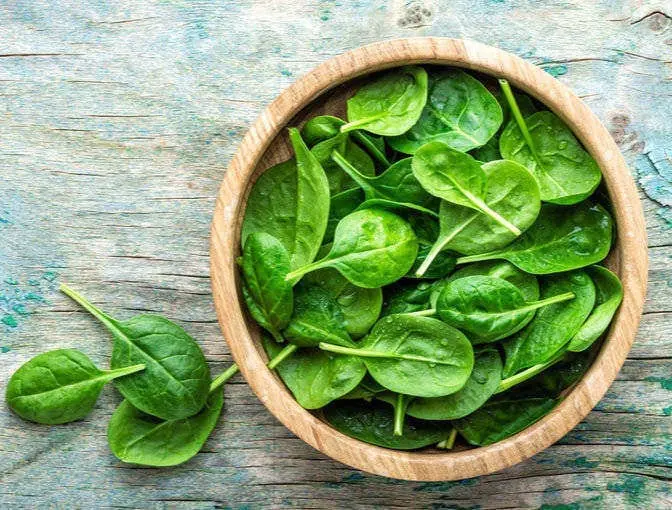
Turns out, spinach is a high-protein vegetable loaded with tons of nutrients in a low-calorie package. They provide protein, iron, vitamin C, calcium, magnesium, and more.
Protein in spinach: One cup (180g) of cooked spinach offers 41 calories, 5.4g of protein, and 0.5g of fats.
35. Asparagus
When spring is around the corner, vegetables like asparagus, spinach, and artichoke are at their freshest!
Grab your hands on some asparagus for a boost of protein, fiber, folate, vitamin A, C, E, and K, as well as antioxidants.
Some benefits of asparagus you probably didn’t know include 1) it can help fight cancer, 2) it is a brain booster, and 3) it’s a natural diuretic, meaning it increases urination thus getting rid of excess salt.
Protein in asparagus: One cup (180g) of cooked asparagus has 40 calories, 4.3g of protein, and 0.4g of fats.
36. Artichoke
Artichoke is one of the protein-rich foods that has been used for centuries for its medicinal properties.
Some benefits of artichokes are lowering bad cholesterol and increasing good cholesterol, regulating blood pressure, and improving liver health and digestive health.
Protein in artichoke (globe or french): One medium cooked artichoke (120g) contains 61 calories, 3.5g of protein, and 0.4g of fats.
37. Brussels sprouts
Brussels sprouts, named after Brussels in Belgium, are cruciferous veggies, the same family as cauliflower, cabbage, kale, broccoli, and others.
Though they taste bitter and hated by many, when they are properly cooked and seasoned, Brussels sprouts offer a natural, nutty sweetness.
They are rich in protein, vitamin C and K, folate, carotenoids (help in decreasing the risk of certain cancers and eye diseases), and fiber.
Protein in Brussels sprouts: One cup (156g) of cooked Brussels sprouts offers 56 calories, 4g of protein, and 0.8g of fats.
38. Broccoli
An equal cousin of Brussels sprouts, broccoli is rich in protein, vitamin C (as much as an orange), and K, B vitamins, iron, magnesium, potassium, and zinc.
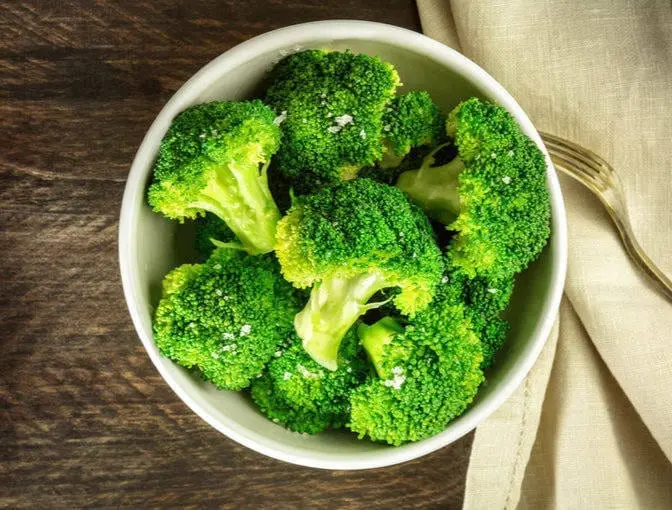
Protein in broccoli: One cup (156g) of cooked broccoli has 55 calories, 3.7g of protein, and 0.6g of fats.
How to Get More Protein in Your Diet?
The vast majority of us have enough protein in our diet; however, we lack high-quality protein, especially from whole foods.
One hack is to practice mindful eating.
Always opt for fresh, whole foods that provide all the nutrients your body needs instead of nutrient-empty processed foods filled with chemicals.
How you cook determines the nutrient content in foods as well. Deep-fried foods may be crunchier but it adds unnecessary oil and fats to your diet, which can increase the risk factors of obesity, high blood pressure, and high cholesterol.
Choose healthier cooking methods such as baking, blanching, poaching, or stir-fry.
‘Diet’ does not mean ‘temporary alteration of your life for short-term gain. It means ‘way of life.’
— Eric Edmeades, Author of Mindvalley’s WILDFIT Quest
The bottom line is,
You don’t have to make drastic changes at once to get more high-protein foods.
Start with substituting beef steak with lean chicken breast. Or replace meat with tempeh. And increase the number of fresh vegetables per meal.
These tiny changes compound over time and will bring lasting changes to your health.
